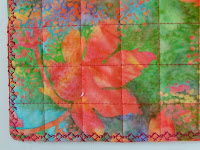So, picking up where I left off last week, I am working on adding detail to the small wall hanging (11” x 21”). The background is very simple, made using strips of ready-fused fabric pressed onto a cotton batting.
Greenery
As this is a small picture, I have decided I would like to try and ‘thread paint’ cow parsley in the foreground for interest. To start, I have free-cut a shaded green fabric with pinking shears to give an impression of foliage and this has been ironed in place.
Greenery detail
Next, I am going to try to use my ‘young’ (I’m not that experienced!) machine embroidery skills to draw the flower itself because I like to stretch myself with each piece I make to ensure that I continue to grow. To do this I have trapped a piece of white sheer between 2 soluble layers and stretched them in an embroidery frame. There are sparkly details on the sheer to add interest.
Visuals and embroidery hoop
Also helpful are visuals like the plant itself (there are plenty around this time of year) and, on a scrap of paper, I have scribbled to main characteristics of the plant such as flower details, leaf pattern, silhouetted shape etc. Now I am ready to sew. Watch this space!
On 28th to 30th of October, I will be attending the autumn quilt festival run by Grosvenor exhibitions at the show ground in Malvern. I will be demonstrating positive/negative appliqué, teaching a mini workshop and selling my book ‘Dual Image Appliqué’. As part of this event, I have been invited to put together an exhibition of my ‘Fabric Palette’ quilts. As I have just entered my Garden Triptych quilt in an American competition, I feel I need to flesh out my display somewhat. So I have decided to do a series of landscapes (I hope!). Here’s how I go about it.
Pattern
I start with a vague idea of what I want to achieve and make a rough pattern; this one has been drawn on the wrapping paper from the meat purchase at a farm food shop. Waste not, want not and all that! The paper has determined the size of the picture.
Each of the simple pattern sections is traced separately onto baking parchment.
I use a varied palette of fabric, prepared with a fusible backing, and cut them into strips with a fluted rotary cutter. I have plenty in stock from previous quilts!
Water and hill
I use the strips to cover the drawn section on the baking parchment and pin it over the pattern to assess progress from a distance.
Foreground
Hills
I have always need lots of colour in my quilts so my landscapes are never going to be traditional. Machine embroidery and texturing will enhance the fabrics and add detail at a later stage. And this is the story so far!







































